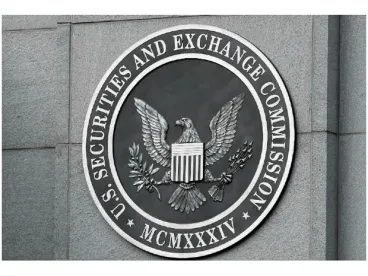On April 29, 2015, the SEC issued a proposed rule intended to implement the pay for performance disclosure required by Section 953(e) of the Dodd-Frank Act. The rule would add new Item 402(v) to Regulation S-K that would require a public company to (1) disclose in tabular format the compensation actually paid to named executive officers and the total shareholder return (TSR) of both the company and its peer group and (2) discuss the relationship of such compensation to the TSR.
Pay for Performance Table
Proposed Item 402(v) adds a new table that requires information regarding compensation as reported on the Summary Compensation Table (SCT), “compensation actually paid” to the named executive officers and company and peer group TSR. Under the proposed rule, the compensation of the Principle Executive Officer (PEO) must be disclosed as well as the average compensation of the other named executive officers.
Compensation Actually Paid
“Compensation actually paid” is defined as the total compensation as reported on the SCT, subject to the following adjustments:
Change in Pension Value: The aggregate change in actuarial present value of pension benefits would be replaced with the annual service cost. This is intended to reflect only the pension cost for benefits earned during a year and eliminate the portion of the change in pension value relating to benefits earned in prior years. The adjustment does not extend to above-market or preferential earnings on deferred compensation because these amounts represent compensation accrued during the relevant year. (Small reporting companies would not be impacted by this adjustment because they do not report change in pension value on the SCT.)
Equity Awards: The grant date fair value of stock-based awards granted during the year, including stock options, would be replaced with the fair value of awards that vested during the year, valued as of the vesting date. The fair value at vesting would be determined under FASB ASC Topic 718.
Footnote disclosure would be required to quantify how the amounts of SCT compensation differ from the compensation actually paid to the PEO and the other named executive officers.
Pay Versus Performance
|
Year |
Summary Compensation Table Total For PEO |
Compensation Actually Paid to PEO |
Average Summary Compensation Table Total for non-PEO Named Executive Officers |
Average Compensation Actually Paid to non-PEO Named Executive Officers |
Total Shareholder Return |
Peer Group Total Shareholder Return |
|
|
|
|
|
|
|
|
TSR
The proposed rule uses the TSR definition in Item 201(e) of Regulation S-K (the annual report performance graph requirement), which is determined by dividing the sum of the cumulative amount of dividends for the measurement period and the difference between the share price at the end and beginning of the period, by the share price at the beginning of the period.
A company must use either the peer group discussed in its Compensation Discussion and Analysis (CD&A) for purposes of disclosing benchmarking practices or the peer group used for the annual performance graph pursuant to Item 201(e). Peer group members must be identified unless the group is a published industry or line-of-business index.
Time Period Covered by the Disclosure
Companies would provide the disclosure for each of the five most recently completed fiscal years. During a transition period, companies would provide the disclosure for three fiscal years in the first filing after the rule becomes effective, then provide disclosure for an additional year in each of the two subsequent annual proxy filings.
Description of Relationship between Compensation and TSR
In addition to the tabular disclosure, a company would be required to describe the relationship between the executive compensation actually paid and the company's TSR as well as the relationship between the company's TSR and its peer group TSR. This would be described in either narrative or graphical form, or a combination of the two. The Release gives as examples a graph (1) providing executive compensation actually paid and change in TSR on parallel axes and plotting compensation and TSR over the required time period, or (2) showing the percentage change over each year of the required time period in both executive compensation actually paid and TSR, along with a brief discussion of the relationship.
Disclosure Requirements – Filings, Format and Location
The proposed rule would require disclosure in proxy or information statements in which executive compensation disclosure pursuant to Item 402 is required, and the information would need to be provided in tagged data format using eXtensible Business Reporting Language (XBRL). A company would have discretion as to the location of the disclosure within the proxy or information statement, although disclosure in the CD&A would be appropriate only if the company actually considered pay for performance in its compensation decisions.
Smaller Reporting Companies/Companies Not Affected
Smaller reporting companies: (1) would be required to disclose the relationship between executive compensation actually paid and the company's TSR, but would not have to provide disclosure of the peer group TSR (smaller reporting companies are not subject to Item 201(e)); (2) would only have to report for the three most recently competed fiscal years (not five), and under the transition period, would only have to report for the two prior years in the first filing required after the effective date of the rule; and (3) would not have to comply with the XBRL format until the third filing.
The proposal would not apply to foreign private issuers, emerging growth companies or registered investment companies.
Comment Period
The SEC has solicited comments on a number of topics. Comments are due within 60 days after publication of the proposed rule in the Federal Register, which is scheduled for May 7, 2015.
Upcoming Rulemakings
Other anticipated rulemakings impacting public companies include the pay ratio disclosure rule, originally proposed in September 2013, and the hedging disclosure rule, recently proposed in February 2015. The expected release date for the pay ratio disclosure rule is October 2015, while comments on the hedging disclosure rule were due by April 20, 2015.
This post was written with contributions from Christine Ayako Schleppegrell and Jason Zgliniec.





 />i
/>i

